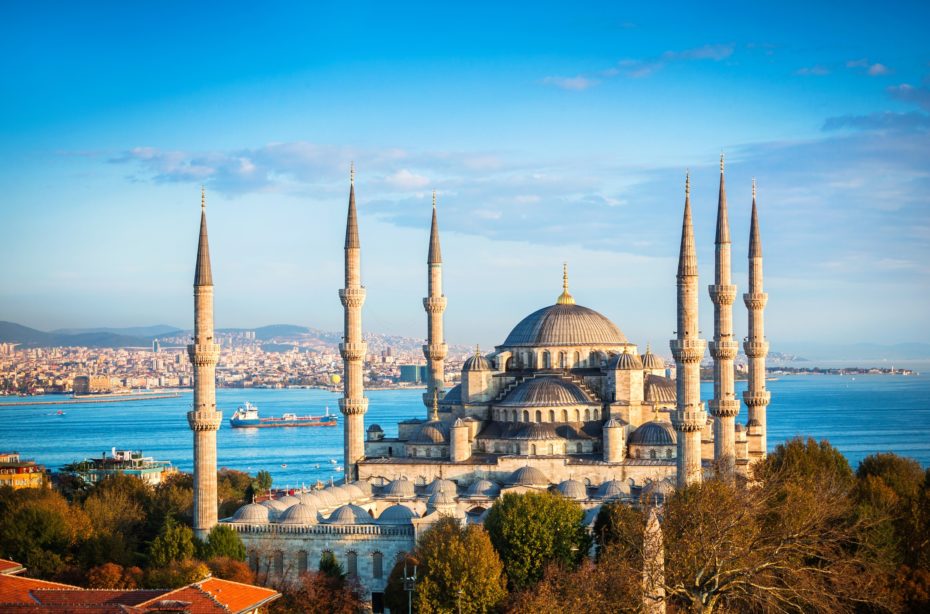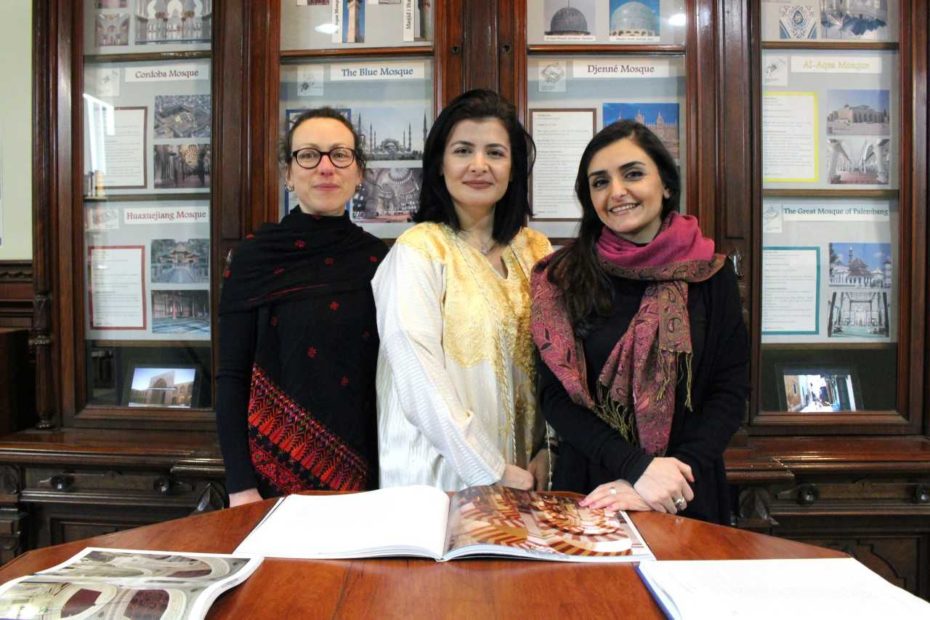
Discovering Mosques of the Islamic World is an exhibition on display until July 31, in the Islamic Studies Library, Morrice Hall. Featuring textual, photographic and video content, the Exhibition gives a glimpse of the great diversity of mosque architecture that exists in the Islamic world, from Sub-Saharan Africa to Southeast Asia, and aims to highlight both common architectural features and regional influences.
Discovering Mosques is curated by Anaïs Salamon, Head of the Islamic Studies Library; Samah Kasha, Senior Library Assistant, Islamic Studies Library; and Ghazaleh Ghanavizchian, Senior Library Clerk, Islamic Studies Library (bios below). The Reporter spoke to them about the Exhibition.
Can you tell us briefly about the exhibit?
AS: Discover Mosques of the Islamic World highlights common architectural elements and features in mosques around the world as well as regional differences. To do so, it showcases breathtaking buildings located in Spain, Mali, Palestine, Iran, Turkey, Russia, India, Indonesia and China. This exhibition is just a glimpse into the great variety of architectural styles that exist, and aims to pique visitors’ curiosity to encourage them to investigate further on their own.
SK: Mosques are one of the most important Islamic buildings. One cannot discuss Islamic Art without discussing Mosques. There are various ways by which one can explore and present mosques; in our exhibit we decided to present mosques based on regional location, which is reflected in the architectural style. On display, we presented eight regions (one mosque for each region), two contemporary mosques, and four architectural characteristics.
GG: This is an exhibition on Mosques, which in the past were primarily a place for Muslim prayer. However, in the course of time the function and form of this place has changed and mosques are no longer only a place for prayer but also accommodate different social, political and religious activities.
Why does this topic interest you?
AS: This topic was chosen in collaboration with my colleagues Ghazaleh Ghanavizchian and Samah Kasha, co-curators of the exhibition. Architecture is one of the most prominent forms of art in Islam in which the best artistic and technological ingenuity has been invested for centuries. In doing preliminary research, we discovered the wealth of the McGill collection on the topic although there is no course focusing on Islamic architecture offered at McGill. Thus, it appeared it was an interesting topic for an exhibition.
SK: The topic is very rich, visually interesting and our Library Collection has great materials for the exhibit.
GG: The aesthetic perspective on this topic interests me the most, as it is fascinating to see how art and architecture was used to value and pay tribute to holy places. It has always been very interesting to me to see how different forms of art were employed to highlight the preciousness and importance of these spiritual places.
For Muslims, the mosque is a place of worship and in some parts of the Islamic world, Islamic artists and architects created mosques to shine like a pearl. I personally think mosques are the physical manifestation of the union of art and love.
Why is this topic important for people to engage with?
AS: This exhibition emphasizes the immensity and the great diversity of the Islamic World at a time when a very simplistic and uniform vision of Islam and Muslims is being depicted by the mainstream media. In addition to providing rich information on architecture as a form of art, this exhibition challenges assumptions in a creative and pleasant manner.
SK: We wanted to highlight the importance of mosques to Muslims as well as the uniqueness of these buildings as they differ in architectural style, functions and history. To break down barriers and build bridges; for those who have never been into a mosque, we give them the opportunity not only to see mosques’ mystical beauty but also to learn about function and history as well.
GG: Besides the fact that it is a relevant topic to the field of Islamic Studies, it is interesting and useful to know about various forms of mosques in different regions of the Islamic World, ranging from very humble and basic architecture to magnificent architectural complexes.
What were some of the great, interesting or even odd things you found in the collection?
AS: For this exhibition, we read and consulted a significant number of books, articles, websites and what surprised me the most is the wealth of resources available on the topic. I was really impressed by the richness and quality of the McGill Library’s collection on architecture, and discovered the unexpected pleasure of browsing amazing pictures of beautiful buildings.
SK: We did things backwards, due to the limited space on in the display case. We started with the final presentation – the design and what types of materials are going to be displayed – before doing the actual research, this strategy allowed us to overcome presentation challenges and to be efficient while preparing for the exhibit.
GG: It is amazing to see how a shared concept among Muslims like mosques can take a different shape, form and sometimes function in different cultures or regions. Moreover, what amazed me the most was the impact of regional construction materials and environmental conditions, on the architecture of the mosques.
Especially in the past, people smartly integrated and localized them in their culture, to the extent that each mosque is significantly different and unique yet reflects the characteristics of that culture or region. Therefore, sometimes only by looking at a mosque you can tell the region that it belongs to. Some outstanding and exceptional mosques have made UNESCO’s world heritage list and will be preserved for future generations (Blue Mosque, Turkey and Masjid I Shah, Iran).
Did you have an “aha!” moment when putting together this exhibit?
AS: Even though I knew that we would encounter a variety of architectural styles, it was amazing to discover how the perfect fusion of local architectural styles and Islamic architectural tradition creates something new, original and unique.
SK: From the humble mosque to the extraordinary one, each one has given us an “aha” moment, believe it or not. These buildings truly have a mystical power and charm.
GG: Most of the moments in the research phase were “aha” moments. Learning about how these huge extraordinary buildings were built in a time with no construction technology or machinery and are still standing centuries later was mesmerizing.
One fascinating thing that I learned was that the dome of some mosques in very dry or semi-desert environments are covered by blue tiles, meant to resemble water and refuge. It is fascinating to see how smart and creative our ancestors were in making this magnificent architecture.
Any other interesting facts or tidbits?
SK: It is interesting to know that a report by Deloitte and Dubai Islamic Economy Development Center, estimated the current number of mosques in the world at around 3.6 million and will rise to nearly 4 million mosques by 2019.
Anaïs Salamon graduated in both Arabic and Islamic Studies from Aix-Marseille University (France), and Library and Information Sciences from Paris8 University (France). She has been an Islamic and Middle Eastern studies Librarian for almost twenty years in a number of academic and research Institutions in France, Yemen, Syria, Palestine, Egypt and the United States. Salamon joined McGill as Head of the Islamic Studies Library in July 2010.
Samah Kasha graduated from the Information and Library Technologies program at John Abbott College in 2018, and joined the Islamic Studies Library in May of that year. The fact that she’s a native Arabic speaker makes working at the Library an interesting experience. Kasha contributes regularly to the Library’s social media accounts and blog.
Ghazaleh Ghanavizchian studied library and information science in Iran and has worked in many academic libraries. She received a second master’s degree in World Heritage Studies in Germany, where she learned a lot about cultural, natural and documentary heritage. In order to link her new field to her information studies background, Ghanavizchian focused her research on documented heritage. In April 2017, she joined McGill and started working in the Islamic Studies Library as Senior Library Clerk.

